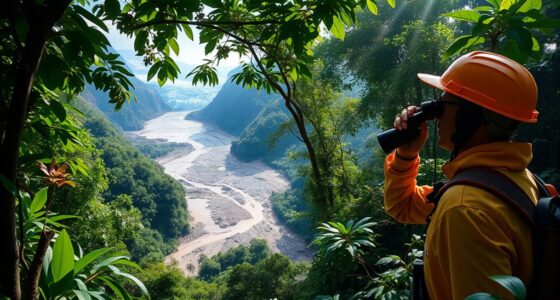Reintroduction and rewilding efforts showcase our ability to repair ecosystems and restore Earth’s natural balance. By supporting these initiatives, you help promote biodiversity, stabilize environments, and foster resilience against climate change. These triumphs demonstrate that human actions can reverse ecological damage and create thriving, self-sustaining habitats. As you explore further, you’ll discover how collective efforts and strategic conservation can shape a future where nature rebounds and ecosystems flourish.
Key Takeaways
- Reintroduction efforts restore key species, enhancing ecosystem balance and resilience against environmental challenges.
- Rewilding projects revive natural processes, promoting biodiversity and self-sustaining habitats.
- Community engagement and conservation strategies are crucial for successful reintroduction and long-term ecological benefits.
- Reintroduction of keystone species improves ecosystem functions like nutrient cycling and soil health.
- Success stories demonstrate how strategic efforts can reverse ecological decline and secure future environmental stability.

Reintroduction and rewilding efforts have recently achieved remarkable success, demonstrating the profound impact humans can have in restoring natural ecosystems. When you engage in these initiatives, you’re helping to restore ecosystem balance—an essential element for the health of the environment. By carefully selecting species for reintroduction and implementing targeted conservation strategies, you help recreate the complex interactions that sustain thriving ecosystems. These strategies aren’t just about bringing back a few animals; they’re about reinstating the intricate web of life that supports biodiversity, stabilizes the environment, and benefits future generations.
You might be surprised how effective well-planned conservation strategies can be. They involve understanding the specific needs of species, their roles within the ecosystem, and the threats they face. When you participate in habitat restoration, monitor animal populations, or support policies that prioritize ecological health, you’re actively contributing to the recovery process. Successful reintroduction projects often require removing invasive species, restoring native habitats, and guarantee that the reintroduced animals have enough resources to thrive. These efforts, combined with ongoing management, help re-establish the natural checks and balances that are vital for ecosystem stability. Additionally, engaging local communities can foster sustainable practices that support long-term conservation success.
Your involvement in these conservation strategies can be as straightforward as supporting protected areas or as hands-on as volunteering for restoration projects. Every action counts toward creating resilient ecosystems where species can coexist and flourish. When animals are reintroduced into their natural habitats, they help control other populations and promote biodiversity, which in turn enhances ecosystem functions like nutrient cycling and soil health. This creates a self-sustaining environment that can better withstand threats like climate change and habitat destruction. Recognizing the importance of biodiversity underscores the necessity of these efforts for ecosystem health and resilience. Furthermore, understanding the history of seed cultivation can provide insights into how ancient practices contributed to sustainable land use and ecosystem stability. These traditional techniques often incorporated indigenous knowledge that supported long-term ecological balance.
Understanding the importance of biodiversity is crucial for effective conservation efforts, as it underscores how diverse species interactions sustain ecosystem health. Reintroduction and rewilding aren’t just about saving individual species—they’re about restoring the harmony that keeps ecosystems productive and balanced. By understanding and supporting these efforts, you become part of a broader movement to repair ecological damage and foster resilience in the natural world. Your choices, whether through advocacy, education, or direct action, help assure that the ecosystems you care about continue to thrive. The success stories emerging from rewilding projects prove that with strategic planning and dedicated effort, humans can turn the tide and bring ecosystems back from the brink. This collective effort not only restores nature’s balance but also secures the benefits of biodiversity for generations to come.
Frequently Asked Questions
How Do Reintroduction Programs Select Suitable Habitats?
You start by conducting an ecological assessment to determine habitat suitability, focusing on factors like food availability, climate, and predator presence. You look for areas that closely match the species’ natural requirements and historical range. This process helps guarantee the reintroduction has a higher chance of success. By carefully selecting habitats with ideal ecological conditions, you support the long-term survival and integration of the species into the ecosystem.
What Are the Main Challenges Faced During Rewilding Projects?
Imagine trying to piece together a fragile mosaic, where habitat fragmentation and maintaining genetic diversity are your biggest hurdles. You face challenges like restoring connected habitats, overcoming human land use, and ensuring species thrive genetically. These issues threaten rewilding efforts, requiring careful planning and persistent effort. You must navigate these obstacles to create resilient ecosystems where wildlife can flourish, even amid the complexities of fragmented landscapes.
How Do Rewilding Efforts Impact Local Communities Economically?
Rewilding efforts can boost local economies by creating eco tourism benefits, attracting visitors who spend on accommodations, tours, and local crafts. You might see new job creation in conservation, hospitality, and guiding services, offering residents alternative income sources. This economic boost encourages community support for rewilding projects, fostering a sustainable relationship between nature preservation and local livelihoods, ultimately benefiting both the environment and the people living nearby.
What Measures Ensure the Long-Term Survival of Reintroduced Species?
Imagine a thriving forest teeming with life—that’s your goal. To guarantee this, you must focus on maintaining genetic diversity, which keeps species resilient against diseases and environmental changes. Predator management plays a vital role, helping balance ecosystems and prevent overpopulation. Long-term survival hinges on continuous monitoring, habitat preservation, and adaptive strategies that foster thriving, self-sustaining populations, turning your reintroduction efforts into a lasting legacy of ecological harmony.
How Can Individuals Support Rewilding Initiatives Globally?
You can support rewilding initiatives globally by engaging in citizen activism, advocating for policies that protect reintroduction efforts, and spreading awareness. Participating in ecotourism development helps generate funding and support for these projects while promoting conservation-minded travel. Your actions, like volunteering or donating, contribute directly to the success of rewilding efforts, ensuring species thrive long-term. Every effort counts in creating a sustainable future for our planet’s biodiversity.
Conclusion
As you witness these emerging wilds reclaim their space, you can’t help but wonder—what’s next? The successes hint at a future where nature heals itself, but questions linger beneath the surface. Will we continue to support these efforts or let old habits reassert control? The path ahead remains uncertain, and only time will reveal if these triumphs can truly reshape our world. Stay tuned—what’s coming might surprise you more than you’d expect.






